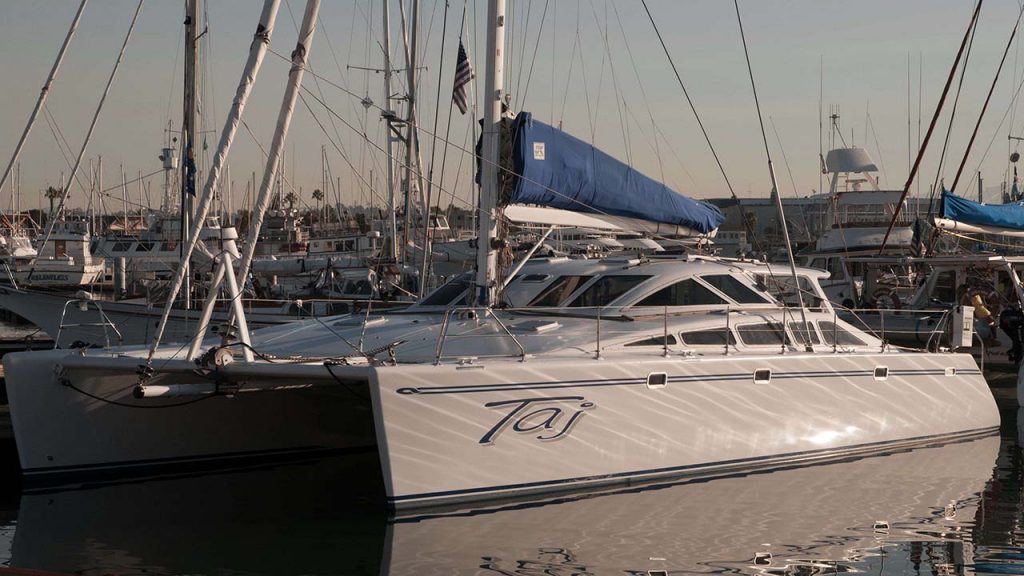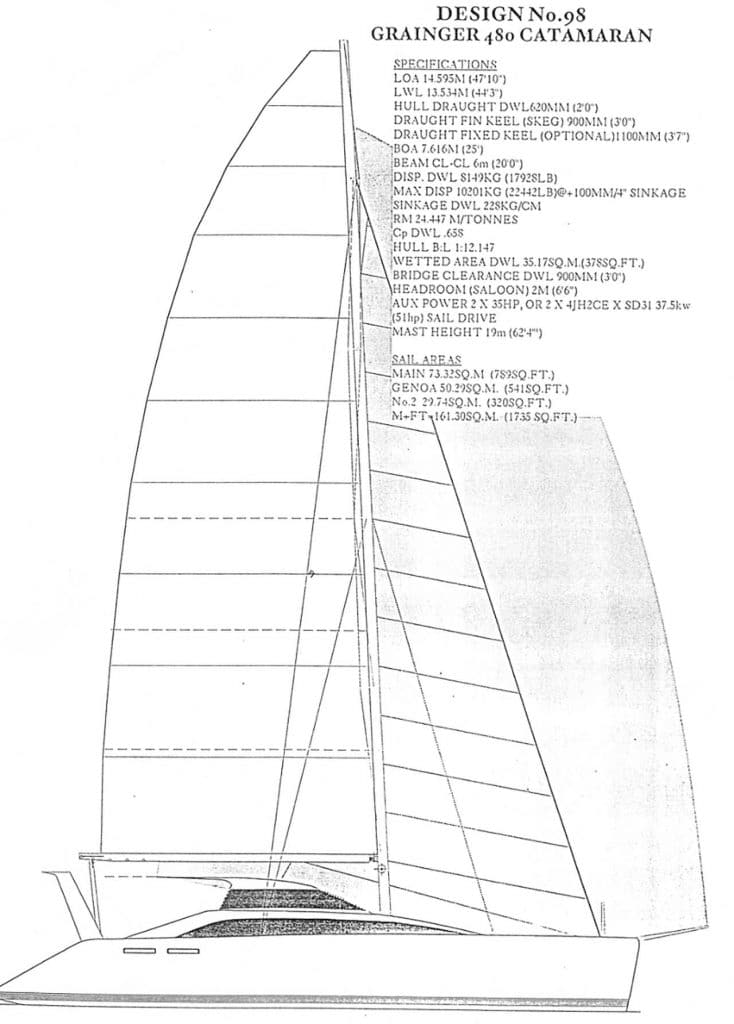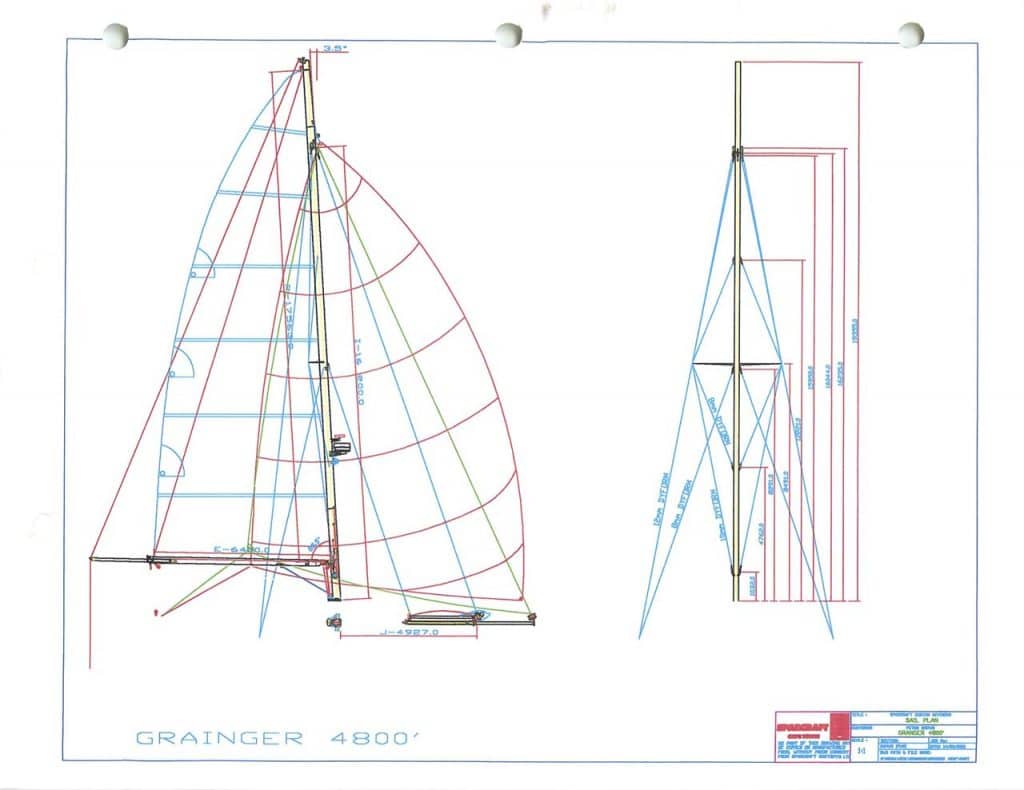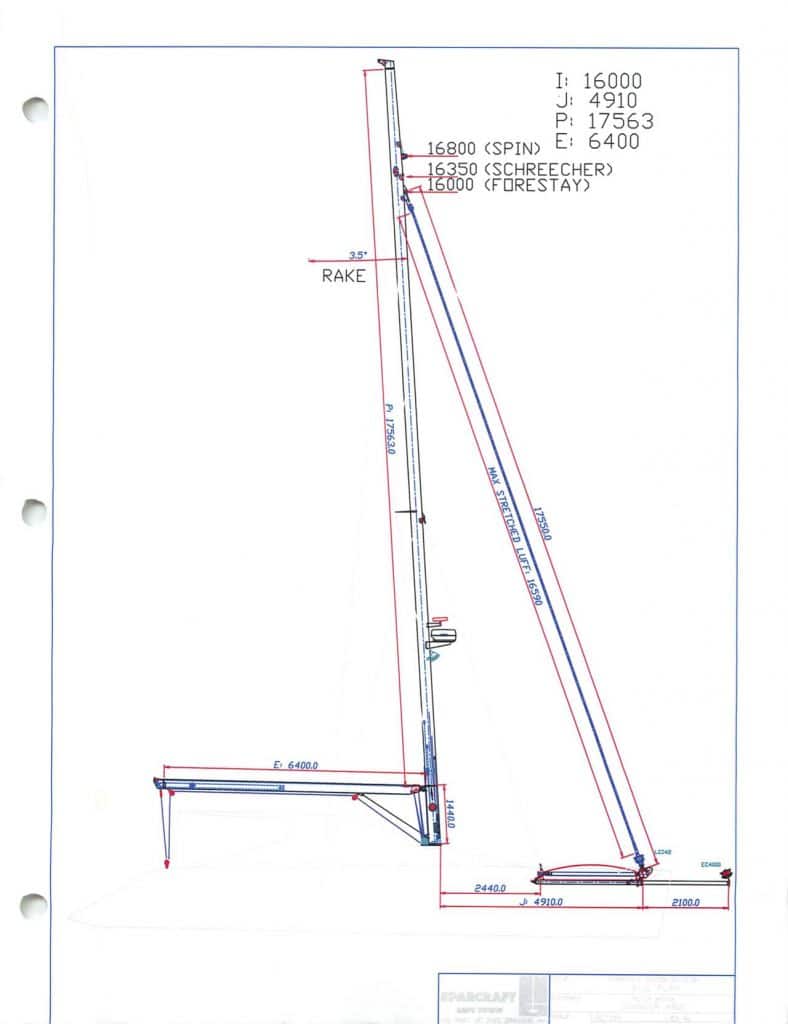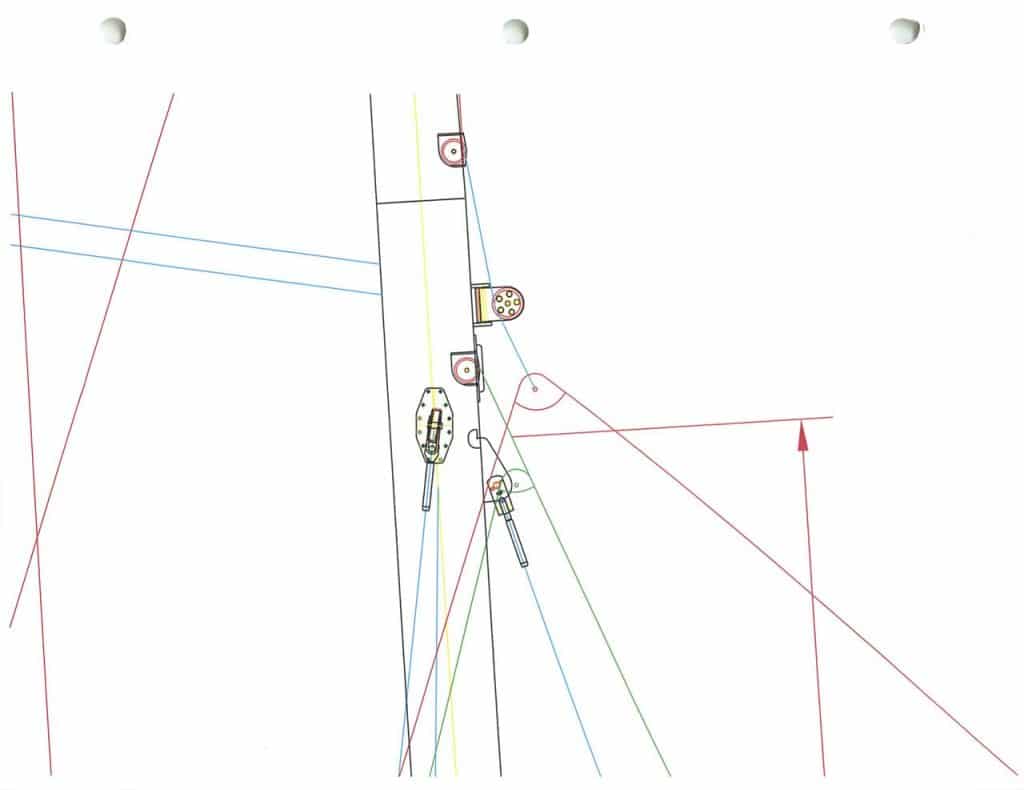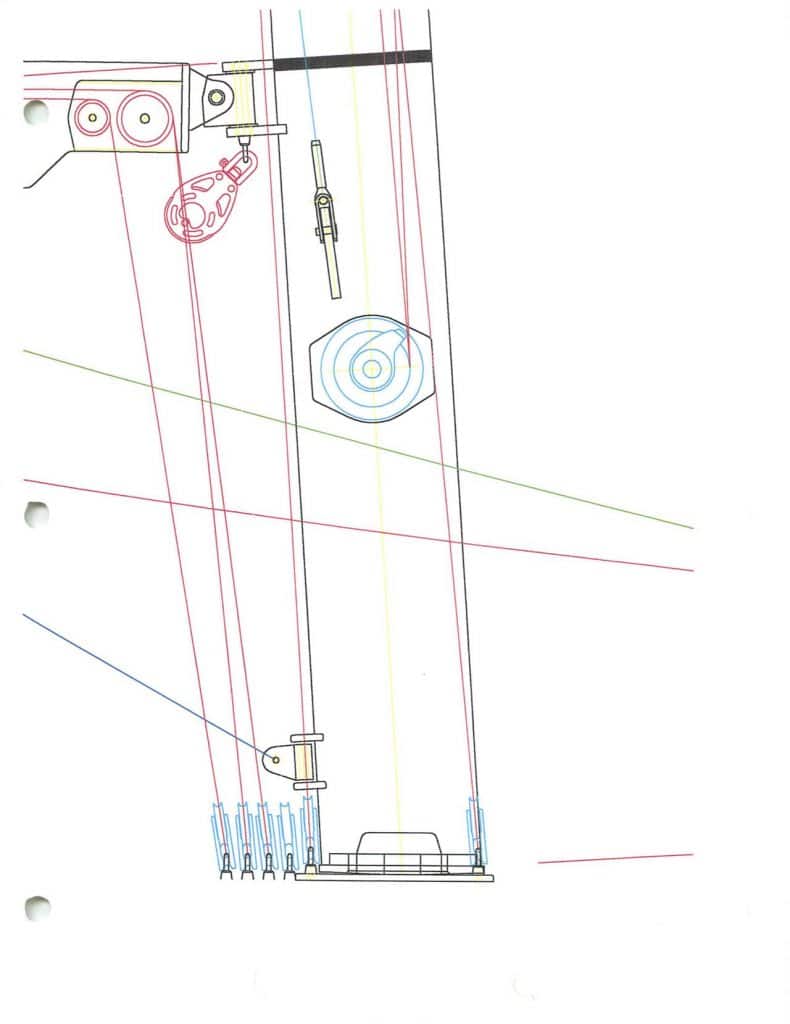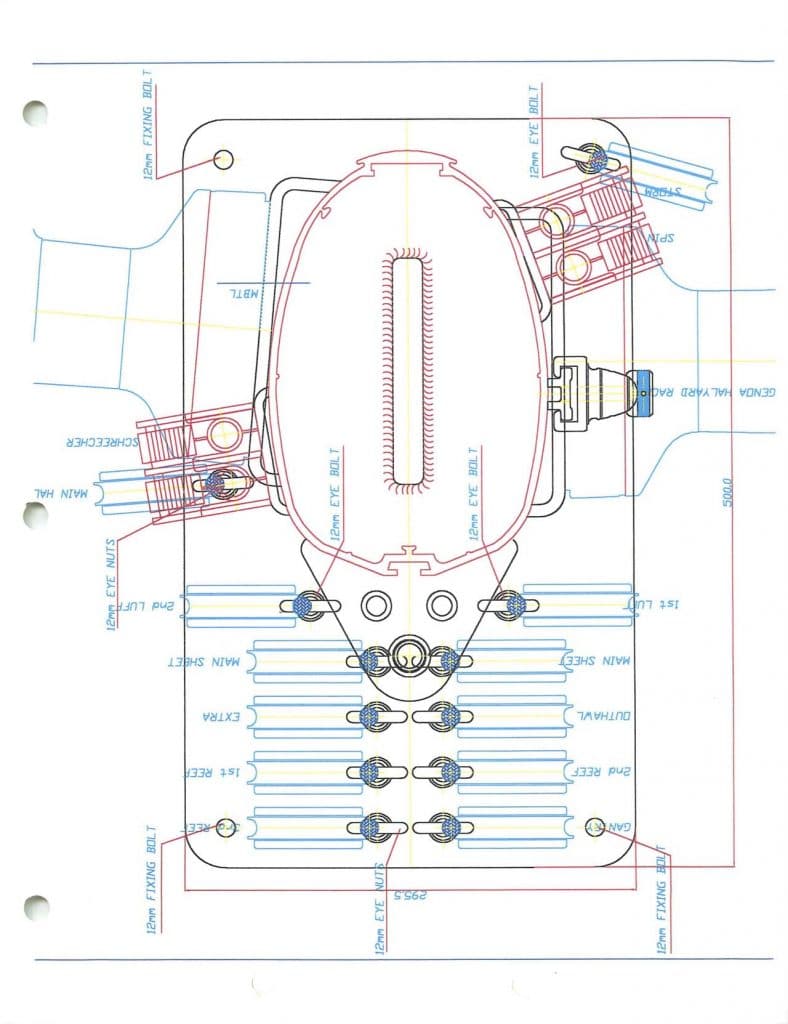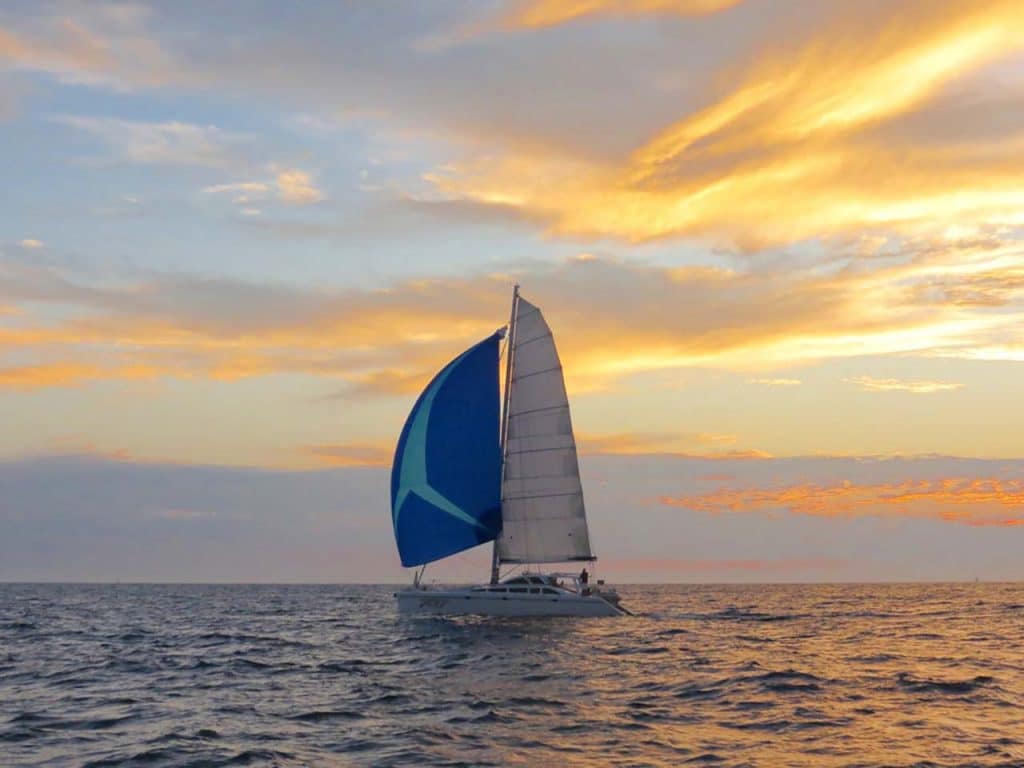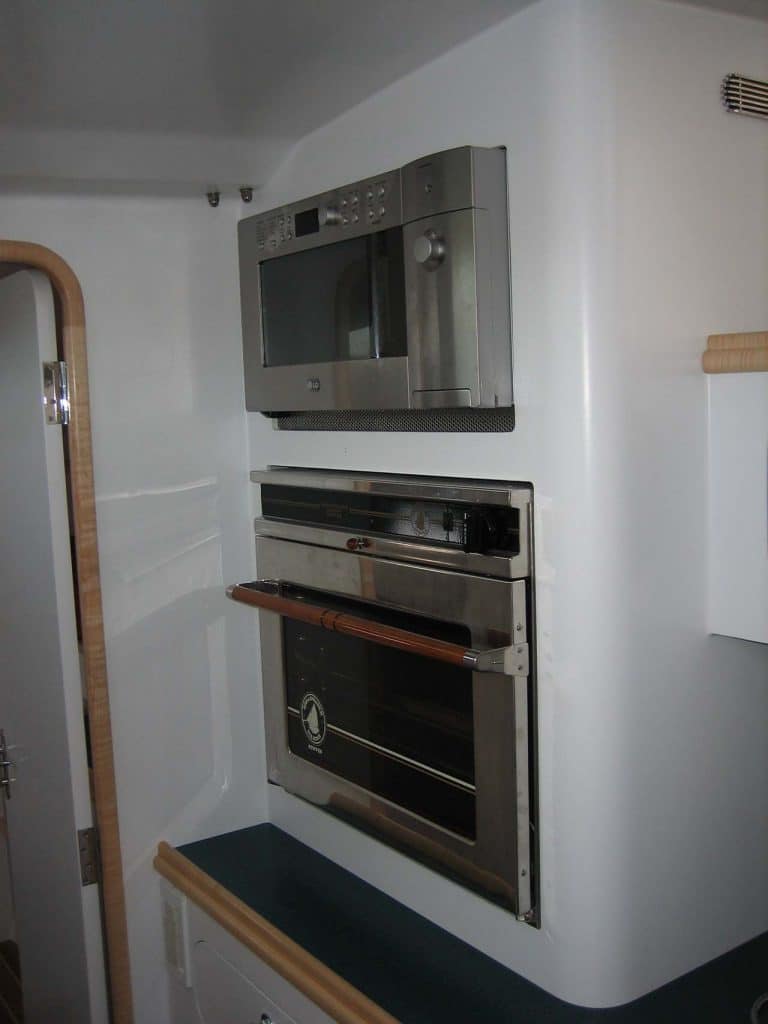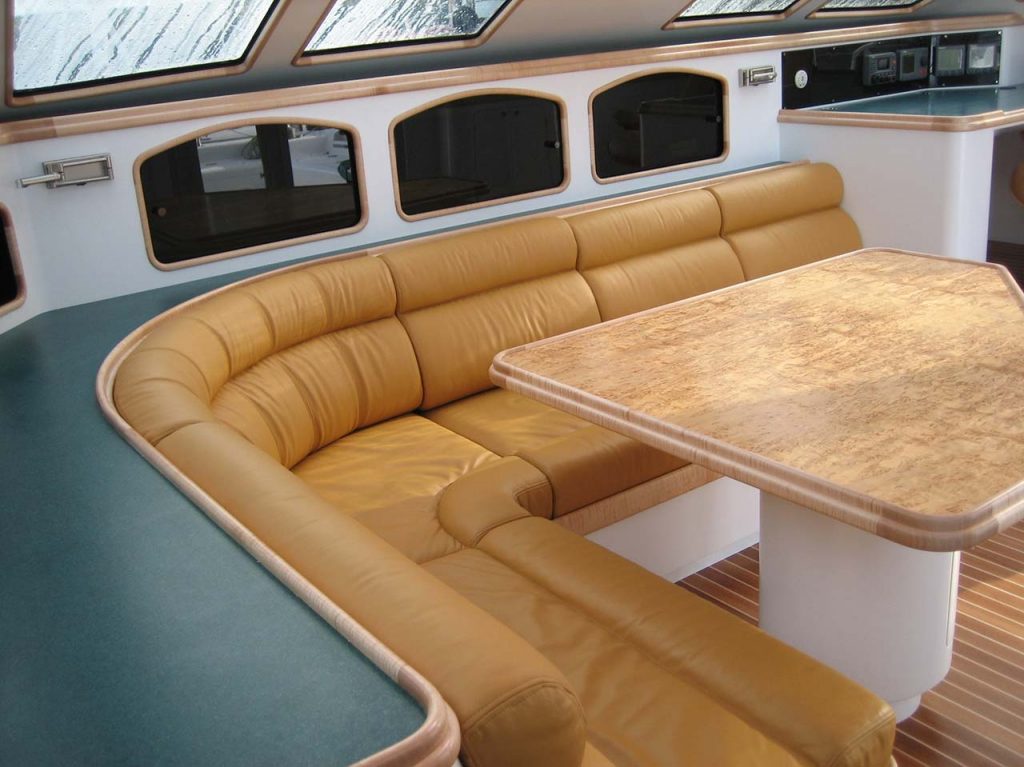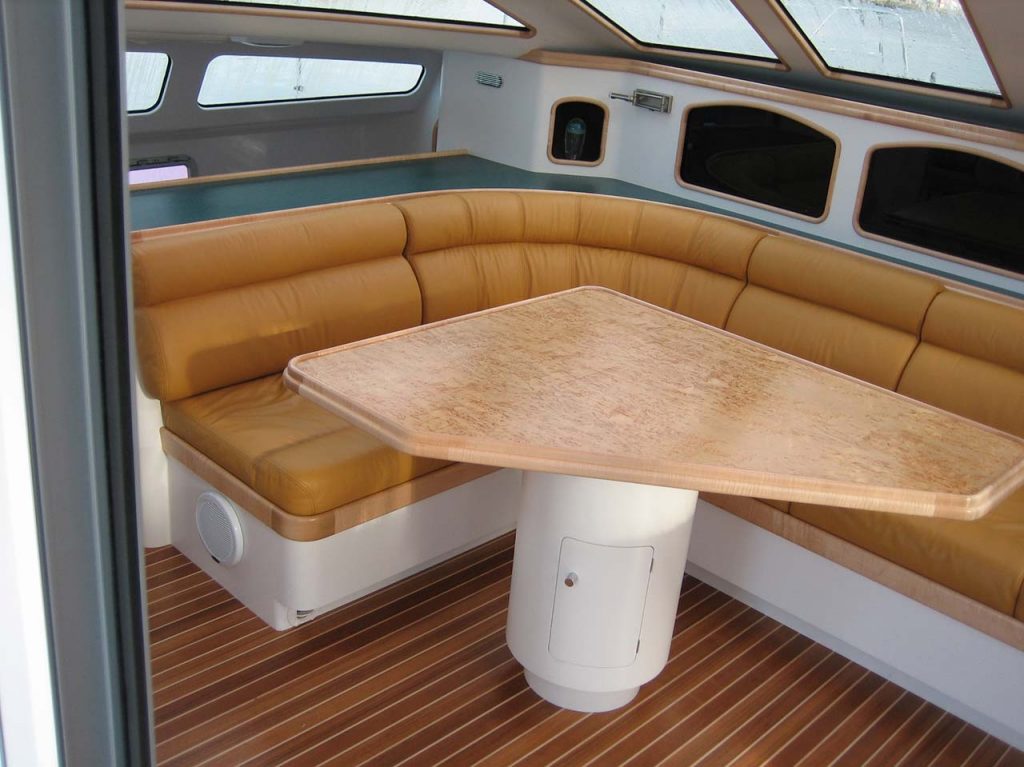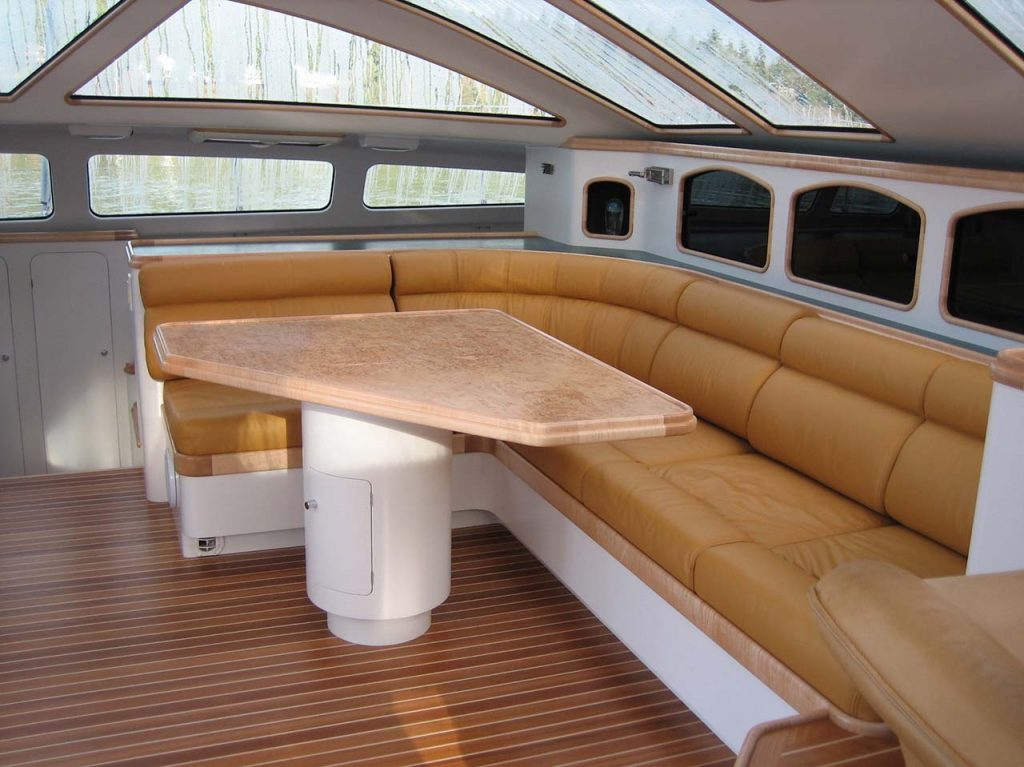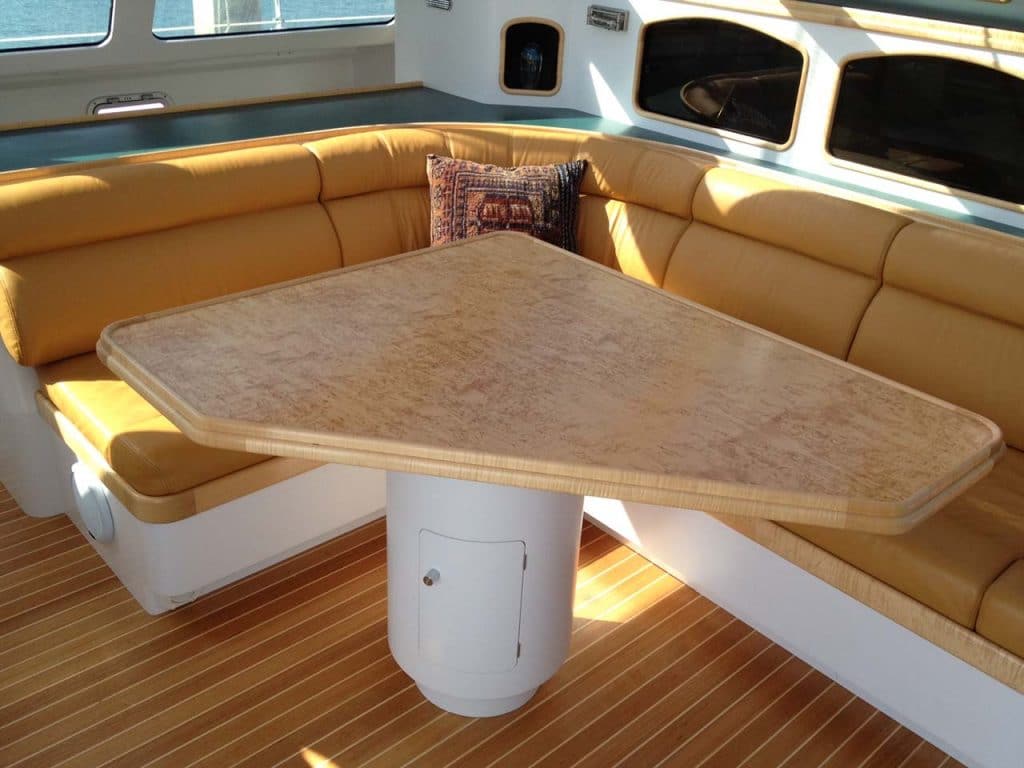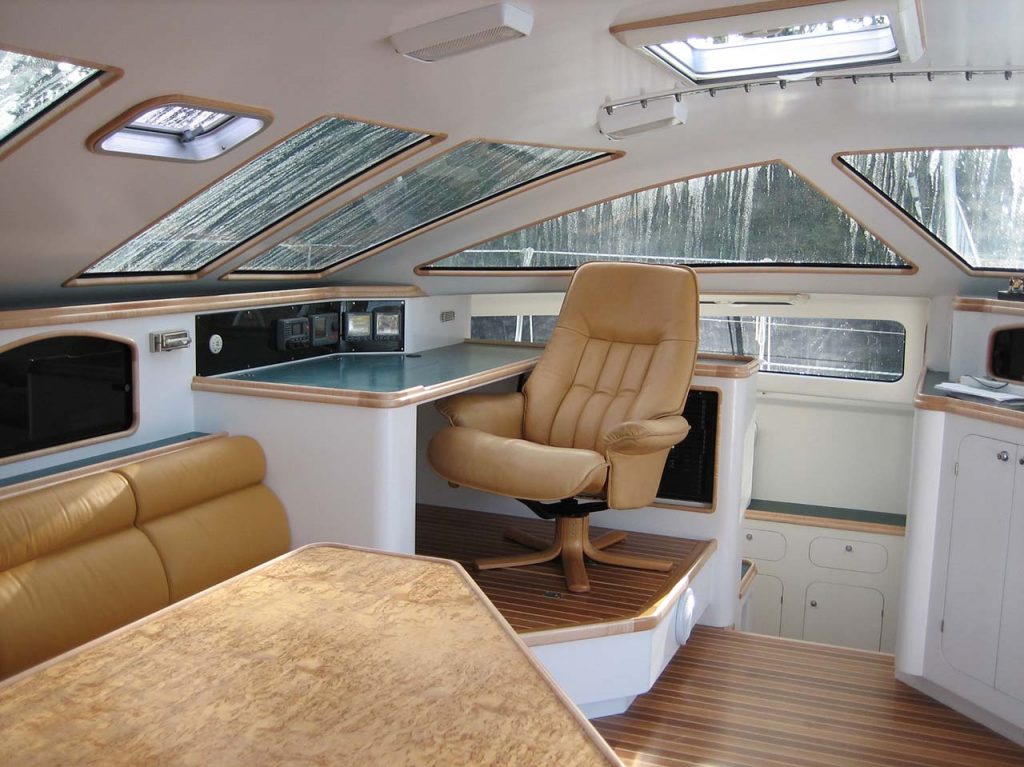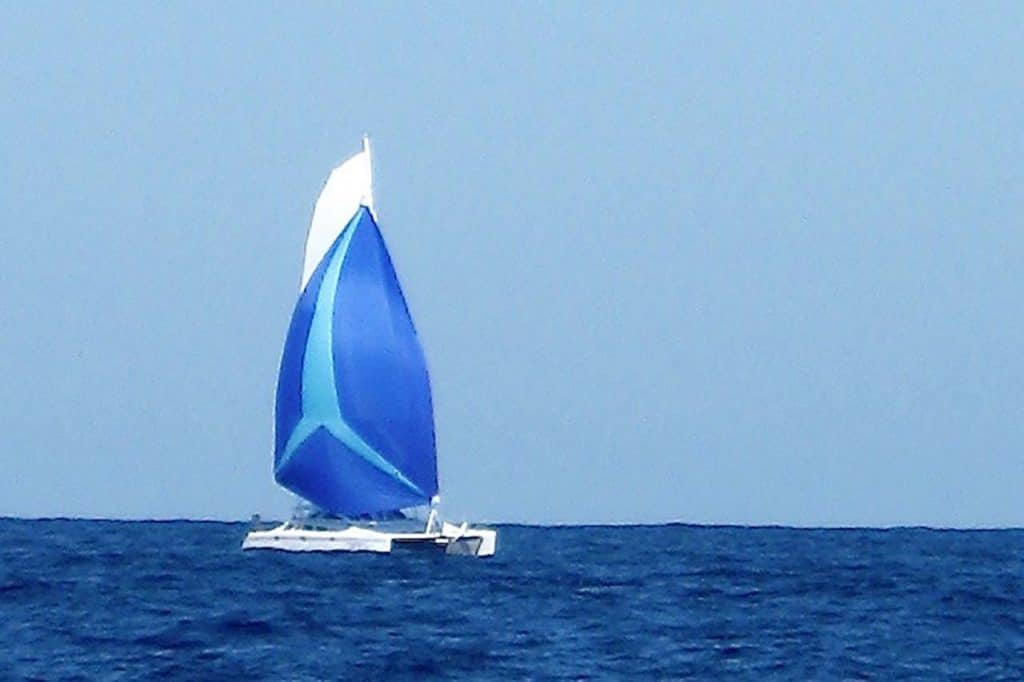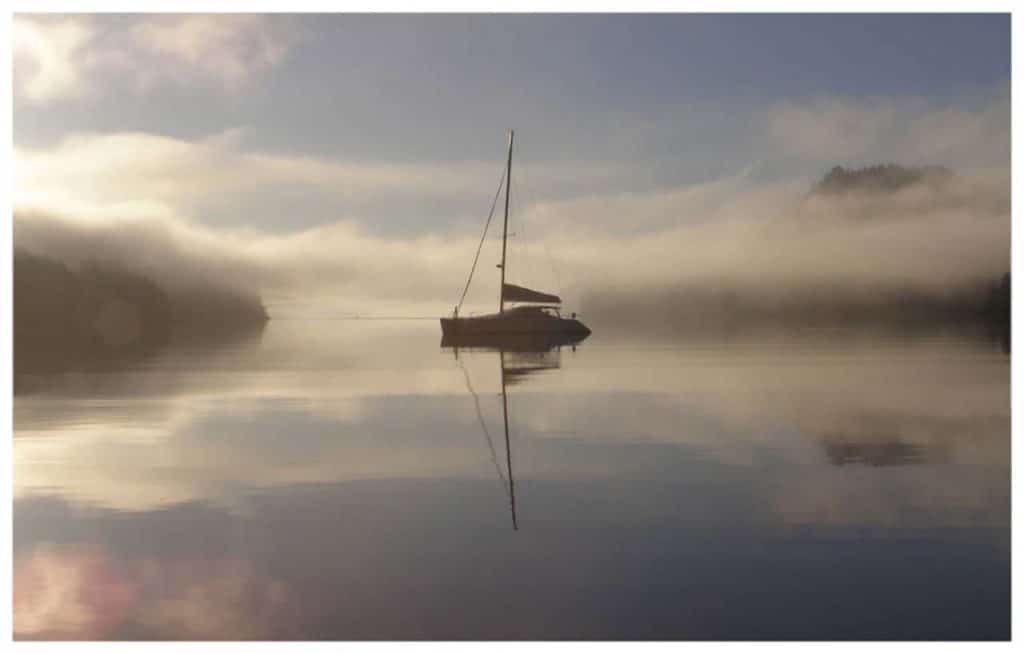Overview – General Specifications
Taj was built to the computer generated plans of Australian designer Tony Grainger – Design 98, and launched in Port Townsend in 2006. Construction was based throughout on the use of West System epoxy, and the avoidance of anything which would cause unnecessary weight. The build teams were professionals selected from the best craftsmen in their trades from the Port Townsend, Washinton boat building community.
The hulls and lower decks are strip planked vertical grain cedar glassed with biaxial fabric. The cedar core was chosen for it’s light weight, strength, and reparability anywhere in the world. Bulkheads, bridge deck and foredeck cross beam were vacuum bagged. The bridge deck was formed from end grain balsa panels, supported by under deck fore and aft stringers.
Upper decks, coach roof, and cockpit are comprised of one inch Corecell foam, glassed with tri-axial fabric. The interior furniture and floorboards are from Nomex honeycomb panels, skinned in carbon fiber or fiberglass. Furniture is trimmed with Eastern figured maple. The main salon table is a honeycomb panel trimmed in maple and Kirilian birch veneer.
Honeycomb floorboard panels and balsa core bridge deck are covered with 3/16” planking in teak and maple. The boat is highly faired, primed, and painted with Sterling Matterhorn LPU paint.
Considerable effort was made to make the boat as effortless to sail as possible. There is a massive Maxwell 3500 electric anchor windlass in a forward deck locker. This can also be used to raise spinnaker and screecher halyards, or to send someone up the mast. Four large Lewmar electic winches are located at each corner of the cockpit. These drive all control lines, the mainsail halyard, and the dinghy launch and retrieval gantry.
Dimensions
- LOA: 47’ 10,” 50′ if the carbon fiber sprit is included.
- LWL: 44’ 3”
- Draft: 4’ 3”
- Beam: 25’
- Beam CL to CL: 20’
- Displacement – approx.: 22,000 lbs
- Waterline beam to length ratio: 12:1
- Bridge clearance: 3’
- Headroom – saloon: 6.6”
Spars
Mast, boom with dinghy launch gantry system, forward crossbeam, catwalk, and Dyform rigging were all supplied on a custom basis by Sparcraft South Africa.
Sprit
The asymmetrical spinnaker and screecher fly from a heavy wall helically wound carbon fiber sprit made by Forte, which is fixed to the forward crossbeam and underside of the foredeck. It is engineered to require no whisker or side stays. Such stays would interfere with an anchor bridle, and are a common source of failure on the more common types of catamaran sprits supported by wire stays.
Sails
- Sails by Quantum: Dimensions approx.
- Mainsail: Full batten flat top. 790 sq. ft.
- The sail is mounted on the Ronstan (previously Frederiksen ) Batten Track Car System.
- Halyard and reefing lines are lead to powered winches in the cockpit.
- Mainsail cover with lazy jacks: UK sails.
- Roller Furling Genoa: 540 sq. ft. on Profurl furling system.
- Screecher: Light air reaching sail on Profurl furling system.
- Asymetrical Spinnaker: 1770 sq. ft. in dousing sock. Blue with teal star.
- Trampoline – Quantum. Lashings recently renewed.
Engines and Engine Rooms
Each hull has the following: A Yanmar Three cylinder Turbo Charged Engine: 3JH2 – TCE 47 hp engine with about 900 hours each of run time. They use SD 30 Yanmar sail drives. Wallas D40 diesel heaters are ducted throughout the hull. Each engine has a high output Leece Neville auxiliary alternator capable of charging up to 170 amps, regulated through Balmar regulators.
Alarms for oil pressure, exhaust temperature, and fuel filter vacuum pressure are led to alarms at the helm. Each engine room has lights and exhaust fans with timed delay shut down.
The port side engine room also houses a Kubota 12 volt generator in a sound enclosure with exhaust cooling water exiting under the hull.
Fuel Tanks and Systems
Diesel: There is an aluminum 60 gallon fuel tank in each hull amidships. There is a reserve 60 gallon aluminum fuel tank (never used) in a foredeck locker. Each hull tank feeds through a Raycor 500FG Series Turbine diesel fuel filter/water separator with solid state fuel pump circuit for bleeding.
Gasoline: There is a purpose built vented, draining locker on the starboard side transom for storage of outboard gas tanks, and barbeque propane bottle.
Water Tanks and Systems
There is a 70 gallon water tank build into each hull under the floor boards just after entry to the forward cabins. There is an additional 70 gallon tank (never used) on the bridgedeck behind the salon settee. Tanks have Wema gauges.
The water maker can select which tank to fill. There is also a valve which permits it to separately fill jerry cans or other containers if desired. Water can be pumped from one side to the other. There is also a cabin top rain catchment system that can fill the water tanks on either or both sides.
Each of the three heads on board has a Bosch self venting propane flash demand hot water system to provide hot showers on demand. Installation is ABYC compliant.
Water maker: There is a Spectra Catalina MK II water maker under the floorboards in the aft port engine room. It was rebuilt to Mark II status by a Spectra technician in 2015, at which time the membrane was replaced, and the Z-Ion feature added. The Z-Ion filtration system enables the required auto fresh water flush cycle to be extended to 30 days between flushes.
Deck Gear:
All hatches are Goiot. They simply do not leak. They also permit a ventilation mode when desired. All major overhead hatches are fitted with Oceanair screen surrounds giving a choice of mosquito or full light shut out modes. Mosquito screens are also available for the smaller or side hatches.
Winches and blocks are all Lewmar, in most cases to high load specification.
All cockpit, transom and deck lockers lock with a custom lock system with the same unique triangular shaped key. No padlocks are necessary.
Foredeck:
There are two large self draining foredeck lockers. To port the locker contains four 30 lb Worthington aluminum propane bottles giving nearly month long refrigeration capacity in one bottle. The locker also houses the Maxwell 3500 horizontally mounted anchor windlass gypsy and chain, fresh and salt water wash down hose bibs, and additional storage for fenders and mooring line.
To starboard, the locker contains a 60 gallon aluminum fuel tank (never used), the electric motor for the windlass, spare anchor, parachute sea anchor and warp, spinnaker, sock, and Screecher sail on roller furler. There is also space for sheets, mooring lines, boat hook etc.
Forward a grated catwalk separates two sides to the trampolines. The primary anchor rests on anchor rollers to port, and there is a spare anchor roller to starboard. At the end of the cross beam there are multiple attachment points for the anchor bridle, and for the sea anchor parachute.
Interior Layout
Interior: A structural forward bulkhead (FB) runs athwartship in front of the settee and serves as the mast step. Another structural bulkhead (AB) runs aft of the salon and separates the cockpit and engine room cabins. Furniture is constructed from carbon fiber skinned honeycomb panels for light weight. All lockers and cabinets have internal venting and many have external venting through custom stainless vents to prevent mildew and preserve clothes in a fresh condition.
Forward Cabins
Each forward cabin is identical, with queen size berth, hanging locker, and multiple lower lockers, including a laundry hamper. Each side has its own head, shower facility and sump pump out.
Galley Area
The galley was designed to preserve sight lines between a standing person preparing meals and a sitting person on the salon settee. There is a four burner stainless Broadmoor cook top, a separate counter high custom Broadmoor stainless oven, and a chest high microwave oven with built in toaster. There is Scandvik stainless double sink with both foot pump and pressure faucet. A Dometic AC or propane fridge freezer is fitted through the bulkhead aft of the galley. Heat vents to the cockpit, as would any potential propane leak. Installation is ABYC compliant.
There are two full height lockers outboard, one for use as a pantry, the other used for foul weather gear and harnesses, and bosun’s chair.
Main Salon
There is a large dining table capable of seating 6-8 persons on custom tan leather cushions. Sight lines are through mid level windows and to the galley. A separate nav. station is raised to permit watch keeping through the upper windows, and has a Stressless leather recliner for seating. This seating arrangement has provided comfortable safe seating through thousands of blue water miles.
Instrumentation includes a Raymarine autopilot control head, Standard Horizon VHF, Icom SSB control head, Raymarine depth, wind, and multifunction gauges. There is an articulating arm which supports a 19 in. Majestic 12v. flat screen used to display laptop charting software (laptop not included.) The custom master electrical panel is to port, providing control of the AC, DC, and charging circuits from the nav station.
There is additional storage in cabinents on the main salon bulkhead, which also include the intertainment console (AM FM CD and Bose stereo speakers.
Storage under the seats accommodates a vast collection of spare parts, rebuild kits, and tools. A custom alcove on the forward bulkhead houses a glass sculpture of a jelly fish by artist Richard Satava, illuminated from below.
Aft Cabin Port Side
Under the floor boards is the Spectra Catalina MK II water maker, and at counter height there is a cold plate top loading Glacier Bay freezer. This cabin tends to be used for pantry purposes, but could accommodate a twin size mattress.
Starboard Side – Forward Cabin is identical to port side.
Amidships
This is an “Owners” dressing and storage area with full height hanging lockers and numerous other cabinets of waist height and below on both sides.
Day head
Moving aft is a day head with holding tank. The tank is above the toilet and can store the flush contents or drain directly to the ocean. If used in storage mode, it can be gravity drained later at sea without the need for a pump out.
Starboard Aft Cabin
Contains a twin size mattress suitable for crew. There are extensive cabinets and lockers, generally used for storage of tools and spares.
Cockpit
There is a large cockpit with locker storage on three sides. A secure custom locker latching system doesn’t require padlocks, but uses a unique triangle shaped key. There is a Scandvik hot and cold fresh water shower station in a built in box. The steering station has Kobelt and Yanmar engine controls, full Raymarine instrumentation, 24 mile radar display and chart plotter, and VHF. Warning alarms for engine and generator functions. The anchor windlass can be controlled from the cockpit with a readout for deployed chain length.
A folding cockpit table with bench seating allows dining for five to six. There is a barbeque with fitting to mount on aft winches.
Custom Diamond Seaglaze double doors with locking dogs inside. Provide entry to the salon. Hanging screens are available. There are custom Diamond Sea Glaze opening windows with screens in thecockpit bulkhead.
Lewmar 54 and 58 power winches control all sheets, mainsail halyard, reefing lines, and dinghy gantry.
Aft swim platform
Fiberglass grating supports a cradle for the dinghy, and easy access for dinghy boarding, fishing, swimming, or stern anchoring. The dinghy is secured with webbing with stainless steel ratcheting buckles.
Transoms:
Both contain vented, draining, and lockable lockers. Both sides have a receptacle for a shore power cable. Two 50’ shore power cables are provided. Each side contains an inflatable Advanced Elements kayak in a storage bag, and a Dahon Tern folding bicycle in a carry storage bag.
Both transoms provide storage for fenders, mooring lines etc. The starboard side also contains the stern anchor and 3/8” chain in chain bag. A separate locker on the starboard side provides vented storage for outboard gas tanks and barbeque propane bottles as well as the barbeque.
There is a folding swim ladder mounted to the starboard bottom level.
Plumbing Systems
Toilets: All toilets are Lavac vacuum system toilets powered by Henderson bilge pump MK IV style pumps. They have never once clogged. There is a spare Henderson pump as well as rebuild kits for the pumps and toilets.
There are Whale Gulper sump pumps provided for all three heads and showers, which also operate through a valve as bilge pumps as well. There are separate Rule bilge pumps in mid and aft hull sections.
Rain Collection – Coach roof rain collection system can fill tanks on either side.
Hot Water – Bosch propane demand flash hot water heaters provide hot water in all three heads.
Fresh Water: There are Jabsco VFlo 5 pumps in each hull, with spare pumps provided. There is a foot pump in the galley for fresh water as well.
Fresh water washdown from foredeck allows washing salt off windows in deck house, or rinsing the anchor and chain.
All through hull fittings are Forespar nylon.
Heating
Wallas D40 diesel heaters in each engine room are ducted throughout each hull with separate controls.
Electrical Systems
Custom Electrical Panel at helm station, and a remote distribution panel in each of the aft cabins.
Battery Banks:
Main bank – New 2012: Four telecom style deep cycle AGM 200 AH batteries, mounted behind settee at boat’s center of gravity.
Starting Batteries: New 2017 replaced both start batteries with AGM Group 31.
Charging Systems:
170 AMP Leece-Neville auxiallary alternators – on each engine regulated through Balmar MC 612 regulators
Kubota 12 v. Generator with Ample Power alternator – charges at 100 amps.
Solar Panels: Three 120 watt panels through regulator.
Inverter Charger: Outback FX Sine Wave 125 amp Inverter charger. There are two 50 foot shore power cables, and input terminals in each transom.
Trickle chargers serve start batteries in both engine rooms.
Isolation: There is an Isolation Transformer in place.
Lighting
All lighting is either florescent or LED. Most of the overhead lighting is from Alpenglow mounted in custom housings. Red night vision lighting is available in all cabins both overhead and at the floorboard level.
Electronics
The autopilot, E 120 chartplotter with 24 mile radar, wind, depth, mulitfunction redundant instrumentation at the helm and nav station is all RayMarine. The autopilot motor is a Lewmar (formerly Whitlock) Mamba rotary drive. There are spare autopilot brains, and drive motors. The masthead light is LED.
AIS is a RayMarine Class B transceiver.
Communications
There is a Standard Horizon commercial grade keypad VHF at the nav. Station, and a Uniden VHF at the helm.
There is an Icom M802 SSB/Ham transceiver and control head at the nav. station, with an Icom AT 140 tuner feeding an insulated side stay, with grounding system. There is an integrated Dragon DR 7400 pactor modem.
There is a Rogue Wave wifi extender mounted up the mast feeding a 12v router on board.
Mechanical Systems
Winches: There are two electric Lewmar 58’s and two Lewmar electric 54 winches in the cockpit. There are two manual Lewmar winches on the mast.
Dinghy Launch is via a square tube gantry system which extends from the end of the boom, and is operated by one of the Lewmar 58 power winches.
Steering: Whitlock Mamba system (Now Lewmar) Large Whitlock steering wheel drives a system of stainless steel tube connected through universal joints to a large sealed gear box located in the aft cross beam. This in turn drives two tie bars to the tiller arms on the rudder stock heads. Rudder stocks are contained in heavy wall fiberglass tubes confined to the transom areas.
Anchor Gear
Primary anchor is a 60 lb Stainless Steel Ultra Anchor with 320 feet of high test 3/8 chain. This is handled by a Maxwell 3500 windlass controlled by either a foredeck hand control, or a remote control at the helm with chain counter.
There is a spare genuine CQR 60 lb anchor in foredeck locker.
A robust anchor bridle and fixed chain hook are permanently mounted to the forward cross beam.
There is a Fortress FX (32 or 37) stern anchor with chain in mess bag in starboard transom locker.
Safety Items
Mooring lines – many of varying lengths. Chain extensions are present for hurricane mooring as well with chafe guards.
Fenders – Approximately 10 Polyform F5 fenders
Fiorentino 18’ diameter Parachute Sea Anchor in launch bag with 400 feet of warp in Starboard foredeck locker.
Ultra Quickline stainless steel stern anchoring reel – 400 feet of high test webbing on a stainless steel reel at port transom. Suitable for stern anchoring, dinghy towing, or stern tie to shore.
Life Sling in fiberglass case at port transom
Four fire extinguishers – serviced 2017 and mounted in custom enclosures at the cockpit and hull companionways. There are spares as well.
There are automatic bilge pumps in each hull.
Escape hatches
There are Goiot purpose built escape hatches located under the companionway steps on each hull. They have security lock out bars to prevent unwanted exterior entry. Each is surrounded by exterior built in fairing to prevent water intrusion at speed.
Detectors
There are carbon monoxide and CO2 monitors through out the boat. Xintex solenoids control the galley appliances and fridge. Bilge water alarms sound audibly and operate the bilge pumps.
Dinghy and Outboard
These were replaced in 2015 with a Highfield RIB Classic 290 (9’ 6”). This boat has Hypalon floatation tubes with an aluminum hull and transom, complete with bow box containing anchor rode and a small Bruce style anchor. The outboard is a 2015 Mercury 9.9 hp. The dinghy is equipped with detachable large diameter wheels. Two people of a certain age can tow this combination up a beach without difficulty. This dinghy will plane with two adults and groceries.
Boat toys
There are two Dahon Tern folding bicycles, two Advanced Element inflatable kayaks, and the usual snorkeling gear for two.
Spares and tools
There are thousands and thousands of dollars worth of spare parts, rebuild kits, and tools to enable repair of virtually any system on board. There is a spare autopilot motor and brain, there are replacement pumps for every pump on board, spare exhaust elbows and risers, filters, impellers, solenoids, wiring and connectors, extensive hand tools, a Fein Multimaster tool, and Dremel tools, as well as wrench and socket sets.
There is an excellent Brian Toss boson’s chair, and a multipart gantline system permitting one person to haul himself manually to the masthead. (Although this can be more easily done with two people using either a cockpit winch or the anchor windlass.)
Recent Maintenance
Taj was hauled in the winter of 2017 and received three coats of blue antifouling. All zincs, fuel and oil filters were replaced. Oil and transmission fluids changed. Sail drive seals were replaced, generator heat exchanger was removed, cleaned and serviced. Exhaust risers were modified to restrict vibration. All fan belts on the boat were replaced. Auxiliary alternator mounting bolts were replaced. Windlass gearbox was serviced and seals replaced. Fire extinguishers were serviced and refilled.
Moorage on the boat at the Palmira Marina, La Paz Mexico has been paid on an annual basis through April of 2018 in an exceptionally well protected slip. The boat is perfectly capable of leaving now for the South Pacific without the addition of any additional equipment.
Commentary about Taj
Comments about Taj have appeared at the following Internet Links:
- Port Townsend Leader: http://www.ptleader.com/news/business/local-tradespeople-build-a-luxury-catamaran/article_2b377010-6fc6-51eb-8cf4-e14ecbafdf07.html
- Latitude 38: http://www.latitude38.com/lectronic/lectronicday.lasso?date=2011-06-24#.WhZJ9LQ-dp8
- Latitude 38 advertisement: https://www.scanmarineusa.com/wp-content/uploads/Taj-Splash-app.pdf
A Word About the Builder
Taj has been conceived, project managed, sailed, and scrupulously maintained by Peter Brown. He’s taken her as far North as Desolation Sound, British Columbia, and as far South as Manzanillo, Mexico. Peter has held a U.S. Coast Guard Master’s License for over twenty years, is a veteran of the Singlehanded Transpac, and has completed a 12 year circumnavigation that took him one and a half times around the world. He has helped deliver boats 65 feet and greater in length as far North as Glacier Bay, Alaska, and as far South as Sydney Australia. Although he has worked primarily as a trial lawyer, he has also had extensive training and experience in traditional boat construction as well as advanced composites. Taj is the second large catamaran whose construction he has overseen.
Taj is a reflection of all he has learned from his experience and over 60,000 miles of blue water sailing. She is ready, willing, and able to take her owner safely and comfortably wherever they may want to go.

